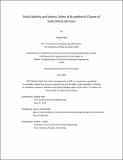Static Stability and Seismic Safety of Brunelleschi’s Dome of Santa Maria del Fiore
Author(s)
Patel, Shailey
DownloadThesis PDF (8.461Mb)
Advisor
Ochsendorf, John A.
Terms of use
Metadata
Show full item recordAbstract
The dome of Santa Maria del Fiore is a long-standing pinnacle of engineering design creativity and fifteenth-century architectural grandeur. Its construction process and stability have been surveyed and researched for centuries. This thesis studies the dome of Santa Maria del Fiore dome in Florence, Italy in a two-fold exploration of its stability limits due to self-weight and horizontal ground acceleration. A parametric model using 2D equilibrium analysis is generated to quantify the minimum horizontal thrusts of the dome in the major and minor directions. The obtained minimum horizontal thrust values from the model in the major axis (5000 kN) and in the minor axis (3900 kN) are compared to existing values in literature. A simplified 2D analytical model predicts the collapse mechanism due to ground acceleration (0.15g) by adjusting the equilibrium analysis used to find the thrust values. This value is compared with experimental values obtained from a static tilt test, where the 3D-printed geometry of the dome and drum is slowly tilted until the point of collapse. The collapse mechanism forms at an angle of tilt of 17.6˚ in the weak direction (0.32g). A 3D analytical prediction is made by analyzing the observed experimental failure plane, which yields a collapse angle of 19.5˚ (0.35g), validating the experimental results. The difference between the 2D and 3D critical values can be attested to the various assumptions made in the conservative analytical model, including the negligence of hoop forces and friction. The analysis within this thesis demonstrates the safety of the dome of Santa Maria del Fiore under expected seismic activity.
Date issued
2023-06Department
Massachusetts Institute of Technology. Department of Civil and Environmental EngineeringPublisher
Massachusetts Institute of Technology